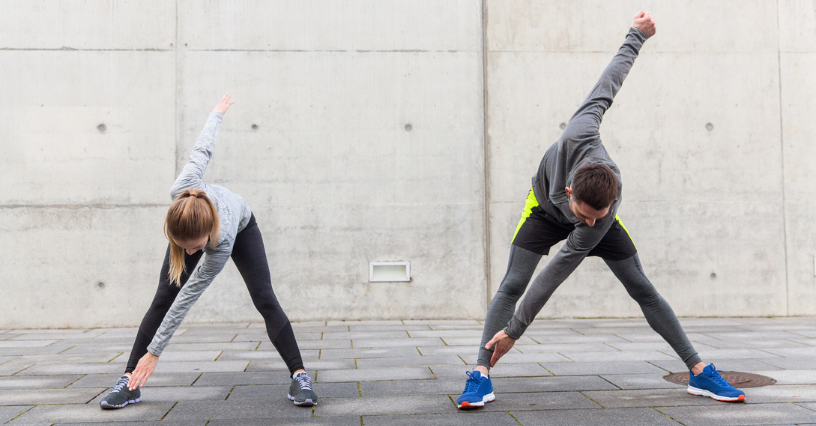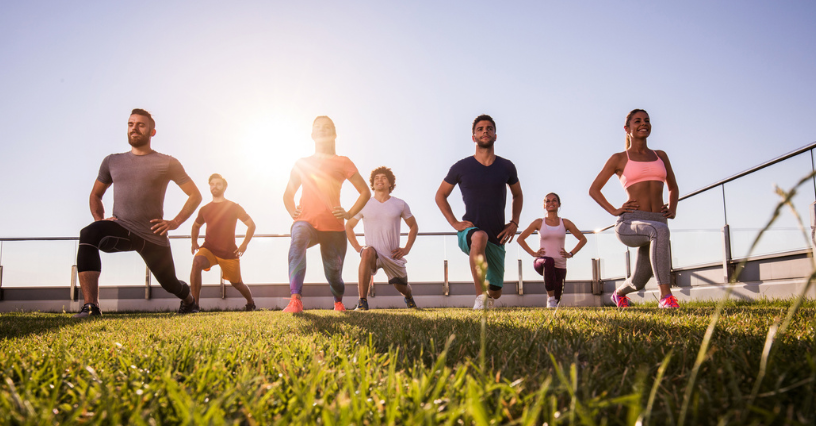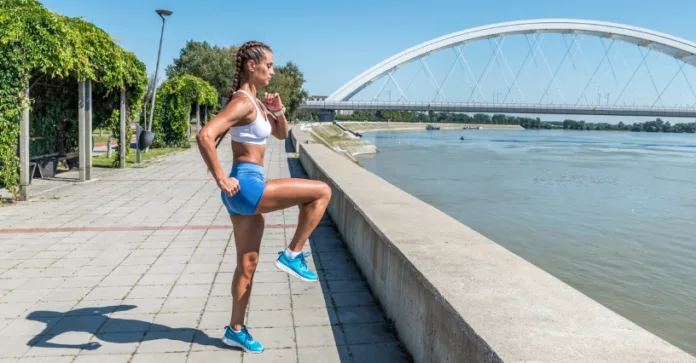Warming up before running is a good practice that will not only reduce the risk of injury, but also increase your training performance.
If you’re not sure what a proper pre-run warm-up should look like, read our tips and learn examples of warm-up exercises for beginners and advanced runners.
Warming up before running – what does it offer?
Limited training time or lack of adequate knowledge of what a proper warm-up should look like are common reasons why it is overlooked. Some runners believe that a brisk walk or run of 5 minutes or 1-2 km is sufficient as a warm-up, and then immediately move on to the main training.
Unfortunately, this often results in lower comfort during the actual exercise phase, a lack of satisfactory results leading to discouragement, or ultimately an injury or injury that limits range of motion or even takes the runner out of the training cycle for a period of time.
If you start a run or interval without a warm-up, you increase the risk of straining muscles (eg piriformis) or Achilles tendinitis (pain in the calf area).
To avoid this, always start running from the proper preparation of the body, regardless of the distance you want to cover, the time you intend to devote to training and the form (jogging, intervals, sprints, running, marathon, etc.

As the name suggests, the purpose of the warm-up is to increase the temperature of the muscles by gradually increasing the blood flow to them. This makes the muscles more resilient and ready to do the right work.
The improved blood flow allows the heart rate to increase, which in turn helps to increase the VO2 max (oxygen ceiling), the maximum amount of oxygen the body can use during exercise. Better oxygenation of the body will result in a faster run.
In addition, warm-up exercises help activate neural connections between the brain and muscles, which improves muscle contraction and strength.
They will also improve the range of motion of the hips, knees and ankles and make the ligaments and tendons more flexible and the body more elastic and agile.
Therefore, warming up makes running easier, more comfortable and safer. Warmed muscles and connective tissues are less prone to injury.
An added benefit of warming up is that you can run a little faster and for longer without necessarily increasing the intensity of your workout, thereby increasing your performance and reaping the benefits of physical activity.
In addition, having a warm-up routine can reduce the stress level associated with participating in running competitions – switching to familiar exercises allows you to relax and gain confidence before the race.

What should a proper pre-run warm-up look like?
Before running, rely on a dynamic warm-up that will include two parts:
- general – is designed to raise body temperature and increase blood flow to the muscles, improving the level of oxygen and nutrients supplied to them. It should involve light to moderate intensity exercise such as brisk walking, jogging etc. Alternatively you can get on a treadmill, ride a stationary bike or jump rope;
- specialist – focuses on stimulating the nervous system and improving range of motion. It consists of exercises that reflect the movement patterns performed during running, for example, lunges, steps, jumps, trunk twists, etc.
How long should the warm-up take?
A good warm-up should last at least 5-10 minutes to get the blood moving and warm the muscles and should focus on all the major muscle groups that will be involved in the exercise.
However, the final duration and intensity of a running warm-up is influenced by many factors, including: fitness level, training intensity, outside or gym temperature, number of layers of clothing worn, personal preference.
As a general rule, the more intense the effort you plan, the longer the warm-up should be. Before intervals or sprints, a 10-15 minute warm-up is useful, which should include lunges, eg segments of dynamic running of 50-100 meters at 70-80% of your capacity.
If you are competing at distances of 5 kilometers or more, you should start warming up 40-60 minutes before the start.
You may want to spend less time preparing for a slow or moderate-paced workout, such as running, jogging. For best results, start with slow movements to build up over time
Does stretching before running make sense?
During the warm-up for running, avoid static stretches, that is, exercises in which you stop movement for a few seconds or tens of seconds. We especially do not stretch muscles that are not warmed up in this way, because you can end up with an injury, such as a tear.
Perform static stretches after exercises or as part of a separate training unit. During the warm-up for running, dynamic stretching is applied that replicates the movements performed during training. This will improve your range of motion, help prevent injuries and have a positive effect on the quality of your training.

10 warm-up exercises for beginners and advanced runners
Perform the following exercises after the general part of the warm-up, spending 45-60 seconds on each exercise. Focus on correct technique and only after you feel confident in an exercise can you increase the pace or add more movements. Here are our 10 warm-up exercise suggestions for beginner runners.
- ALTERNATE ARM CIRCLES
How to do it: Stand with your feet hip-width apart. Circle forward with your right arm. At the same time, you start making extended circles with your left arm behind you. Perform 10 repetitions and change the direction of the arms – left arm forward, right arm back.
- SIDE SQUAT/SIDE SQUAT
Although running primarily moves you forward, this exercise will strengthen your glutes and mobilize your hips, knees and ankles.
How to do it: Stand in a narrow position – feet close together with toes slightly pointing outwards. Pull your shoulder blades toward your spine and down to straighten your back. Stepping to the right side, push your hips back and simultaneously bend your right knee to lower into a squat, leaving your left leg straight. Return to the starting position and repeat the movement on the left side. 10 repetitions are performed on each leg.
- LEG SWINGS FORWARD, BACK AND SIDE
How to do it: Lean against a wall and rest your hands on it at shoulder height (easier version) or stand shoulder-width apart without leaning on it (more difficult version). Bend your right leg slightly at the knee and start rocking from side to side. Perform 10-12 repetitions of each movement and move to the left side. Next, position yourself with your right side against a wall and begin to stretch your legs back and forth. Switch sides and do the same number of repetitions on the other leg.
- KNEE HUGS AND STANDING ON TOES (KNEE HUGS)
How to do it: While marching, alternately pull your knees toward your chest – hold your leg for 1-2 seconds by catching it under the knee while simultaneously stepping up onto your toes.
- STEPS FORWARD AND BACK
Back steps: Position your feet hip-width apart. Rest your hands on your hips or actively work with your hands (opposite hand to leg). Step back and bend your leg at the knee so that it is lowered above the floor. Do not arch your lower back. Make sure the front knee doesn’t come out more than above the ankle (viewed from above). Come back and do the exercise on the other leg.
Forward steps: Position your feet hip-width apart. Place your palms on your hips or actively work with them (opposite hand to leg). Take a step forward lowering your back knee as low as possible. Avoid arching your lower back and bringing your front knee over your toes (from above, your knee should be over your ankle). Return to the starting position and repeat the same for the other leg.
- SKIP A and C
Skip A is a high lift of the knees to the chest in a stationary run, while skip C is the heel touch of the buttocks.
Skip How to: Position your feet hip-width apart and start running steadily in place with your knee in the air. Don’t forget to alternate arms.
Skip C execution: Position your feet hip-width apart and start running steadily in place by bending the leg at the knee and pointing the heel towards the buttocks. on the spot with each leg elevated. This stretches your legs and helps warm up key running muscles.
- INVERSION OF THE KNEE IN THE MOVEMENT
Execution: In a steady forward march, with each step alternately raise the knee to the hip and perform an inversion movement (the knee must go to the side and back).
- DEAD BUG
The Dead Bug is a great exercise that activates the deep muscles, so you’ll be able to maintain good posture when running and reduce strain on your lower back.
How to do it: Lie on your back on a mat. Raise your legs and bend them at the knees so that they are above the hip. Straighten your arms and position them above your chest. Press your lower back into the mat, drawing your navel toward your spine. Maintain this back position throughout the exercise. Straighten your right leg and lower it as low as you can until you can keep your lower back off the floor, while lowering your left arm behind you towards the floor as far as is comfortable. Pause the movement for 1-3 seconds and begin to return by simultaneously raising the arm and leg back to the starting position. Repeat with left arm and right leg. This is a single repetition.
- MOUNTAIN CLIMBER
How to do it: Get into a high plank position + hands under your shoulders, feet hip-width apart, navel tucked in toward your spine, back straight, buttocks tight (your body should form one line). While running (easier variant – walking, intermediate variant + jumps) alternately pull the knees towards the chest.
- BEAR PLANK + PIKE PLANK
How to do it: Kneel with support – knees hip-width apart, hands under shoulders. You tense your abdominal muscles and buttocks. Lift your knees low above the floor. Then lift your hips up so that your body resembles a V.



